The Lion in the Living Room
Air Date: Week of October 21, 2016
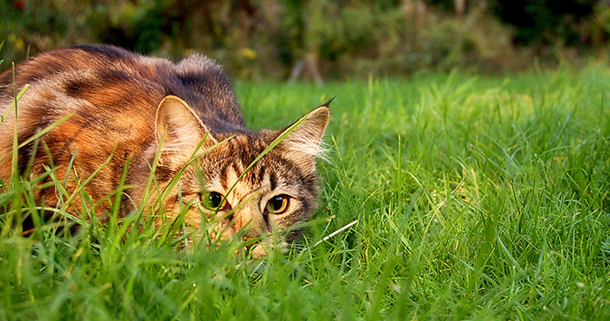
Even as they’ve comfortably moved into domestic life, cats haven’t compromised too much of their self-sufficiency – they still have the ability to hunt in the wild as feral cats. (Photo: Jennifer Barnard, Wikimedia Commons CC BY 2.0)
America is a nation of cat-lovers, but the reality is that they don’t always bother to love us back. They don’t need to, as we provide for them anyway, according to a new book, The Lion in the Living Room. Author Abigail Tucker and host Steve Curwood discuss how housecats came to thrive in a human-dominated world, and how, in reality, we didn’t tame them, they tamed us.
Transcript
CURWOOD: The world has plenty of cat lovers, and here in the US, housecats outnumber dogs three to one, which seems a bit counterintuitive, considering that Fluffy doesn’t seem to give us the unconditional adoration we get from Ruff. But Abigail Tucker says there’s a reason why cats came to rule the roost, and, she says, they really do rule the roost. We didn’t tame them. They tamed us.
That’s the subtitle of her new book “The Lion in the Living Room.” Abby, welcome to Living on Earth.
TUCKER: Thank you so much for having me.
CURWOOD: Yes, your book is called the "The Lion in the Living Room: How House Cats Tamed Us and Took Over the World".
TUCKER: That's right.
CURWOOD: So, exactly how much of a success story is that of the modern house cat?
TUCKER: It's really kind of a staggering success story because there's at least 600 million and some people think closer to a billion house cats on the planet today which is a shocking number for an animal of any kind. It's especially shocking, though, because house cats are, of course, felines. In nature, felines are relatively rare because they tend to sit atop whatever ecosystem they're in, and they have these huge protein requirements that they have to satisfy, so they're actually rarer than other kinds of carnivores typically, and in the modern age the feline family has been in a lot of trouble because basically they clash with people over meat. And so it's even more spectacular that house cats have been able to carve out a global spot for themselves when so many of their wild relatives, from tigers to sand cats to pretty much any other member of the feline family, have come on hard times in recent years because of their long-standing animosity with man basically.
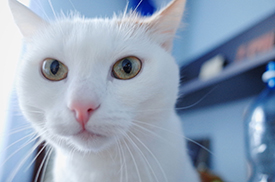
Cats were originally attracted to human settlements – especially our trash. (Photo: Anton, Flickr CC BY 2.0)
CURWOOD: So, what's the secret of success for the house cat and the role of humans in that?
TUCKER: Well, basically house cats have been able to succeed by sidling up to humanity and harvesting our resources without giving us too much in return and also without compromising their feline forms in a way that would prevent them from surviving without us. Cats have undergone this very interesting and complicated process of domestication, but only to a degree, and they have changed the structure of their brain to get along with us better, but they haven't really changed their bodies that much, and they remain hunters as magnificent as tigers or lions or any other member of the wild feline clan.
CURWOOD: To accomplish this, how did house cats manipulate humans in their rise that they can be such huge numbers, be in our cities and you know be in our houses, or not? How did they do that?
TUCKER: Well, basically, the story goes back about 10,000 years ago to the first permanent human settlements that popped up in the - in the Middle East, in the near east, and basically in these settlements humans began changing the environment in really profound ways and then they started making homes and ultimately planting crops and all the things that would doom many of their wild relatives, and they, as humans, began just taking up more and more space. But rather then fighting with humans and having conflict with humans, cats, sort of lured by our trash came closer and closer into our settlements and started changing themselves to get along with the times rather been struggling against humans, basically as lions and other kinds of wild cats tend to do.
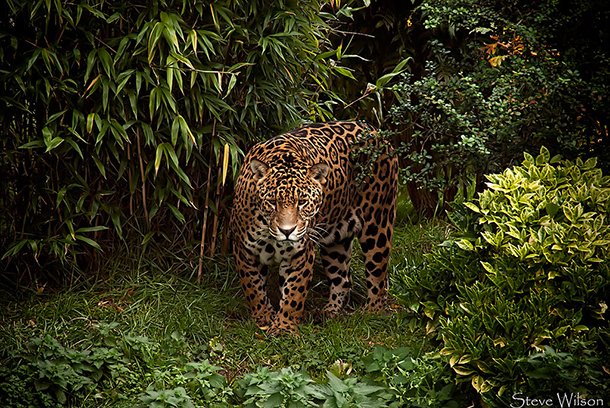
The large members of the feline family are rather uncommon in the wild, since cats require so much concentrated protein – more than 70% of a cat’s diet is meat. (Photo: Steve Wilson, Flickr CC BY 2.0)
CURWOOD: Yeah, one the things that's a little bit surprising your book, Abby, is that you say that in our society we think of cats as great for going after vermin, mice, and rats and yet at the end of the day where there more cats or more mice, there seem to be more rodents. What's going on? Cats aren't living up to this imputed bargain that I thought we had with them.
TUCKER: Yes, it's really interesting. One of the things that's kind of fascinated me about learning about cat-human relations in a more formal way is all these stories that we kind of make up to make excuses for cats and to explain why we have these animals around and, of course, the classic story is that these animals are very important for vermin control.
Scientists from Johns Hopkins have had this ongoing rodent ecology project going on for maybe 50 years, and they basically have been hanging out with Baltimore's many rats and seeing how they live their lives in these alleyways and watching to see what impacts their ecology. And at one point in the ’80s one scientist who I met with decided to watch the effects of Baltimore's many stray cat on these alleys, and he kind of charted it out, and he found that cats do in fact live in alleyways with more rats and sort of the cat excuse for that would be, oh, that's because they're bravely killing out these rats which are so harmful to human health. But actually what he found was that cats and rats do not fight in these environments at all and that they are more or less peacefully sharing another resource which is trash.
CRWOOD: So, in other words, the Hanna Barbera cartoon series Tom and Jerry, the cat Tom never catches the mouse. This is the reality.
TUCKER: [LAUGHS] Yes, That's exactly the reality.
CURWOOD: You make it sound like, in some respects cats are rats with fur that purr.
TUCKER: [LAUGHS] That's really interesting. I mean, scientists do you think of them, as the pathway that they followed to come and live with us in our settlements, in our cities…Scientists do think of them almost more as animals like rats or pigeons that became affiliated with people without ever really coming under their control.
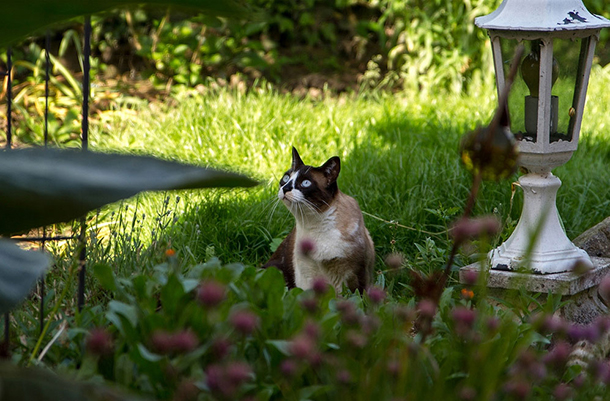
Cats are highly adaptable and can live in a wide variety of environments (Photo: Michael Frank Franz, Flickr CC BY 2.0)
CURWOOD: Now, you know, one of the takeaways from your book is the sheer scope of the cat population, this big rise over the last few decades, and then the feral cat population across the globe. I think you write that in the US there are as many wild or feral cats as house cats, and in Australia it's like a six-to-one ratio of feral cats to house cats. So what's the genetic difference between feral cats and house cats, or is this strictly a matter of upbringing?
TUCKER: Yeah, I mean that's one of the really interesting things. We tend to classify these animals as different, very different in our minds and think of the stray cats as being wilder and in some ways different than our very pampered house pets, but actually, genetically they're exactly the same animal. I talked to scientist who studies, who’s an expert in carnivores and he was doing a study in Madagascar and studying a different kind of animal, and he begin catching these cats in his traps and they were so big and so fierce and so formidable that he actually ran genetic tests on them to ascertain that they were in fact just regular house cats that had been living in the Madagascar interior for, you know, maybe a couple of hundred years but genetically they're just the same kinds of cats as we have in our own homes, which is kind of spectacular. It's this idea that cats can... They're so incredibly adaptable that they can make a go of it in a studio apartment or patrol thousands of acres in the middle of the woods and do fine in either environment.
CURWOOD: Now, you say there are about a billion cats around the planet. How many birds do these cats kill in a given year?
TUCKER: You know, right, so that would be a billion cats - owned pets as well as strays - and the estimates that we get from federal scientists are that these cats kills billions of songbirds per year and also wreak havoc on small mammal populations, and they also kill plenty of amphibians and even insects. But it's also interesting just to think about where the food in your cat's canned food comes from as well. I mean, the fascinating thing about cats and what makes them such unusual candidates for being a globally invasive species is that they're what's called hyper-carnivores, so that means that more than 70 percent of their diet is meat.
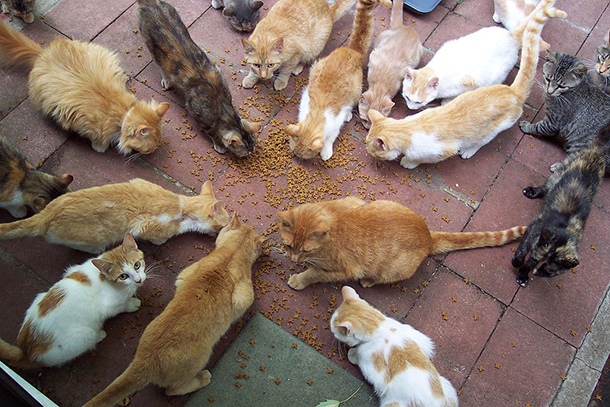
Cat lovers who look for strays will find plenty eager to be fed. (Photo: Scott Granneman, Wikimedia Commons CC BY-SA 2.0)
Cats basically eat meat and nothing else, so whether they're going out your garden and hunting a chipmunk or eating something that they get in a can, which could be a wild sardine caught in a far off ocean or a chicken raised a farm somewhere, all these things are meat, and all these things have an environmental impact. So, in a way I think it's a little limited to just think of, “OK, well, my cat is inside so it doesn't eat any wild animals.” That's important, and that's good, but it's not that your cat is existing on, you know, on air and water alone. You know, these animals eat things, and the fact that they do take a toll on the environment and on human resources only makes it more interesting that we tolerate them and even encourage having huge numbers of them around.
CURWOOD: Looking ahead at how cats might involve. What are the indications for what future house cats might look like given their pace of evolution?
TUCKER: Yeah, that's a really interesting question. So, basically one of the things that I learned when reporting this book is that so far humanity has really had no intentional impact on the way that house cats look or behave. We've influenced them certainly because they sort of came to be because of our settlements, but we never exerted any intentional control over these animals, and that continues today.
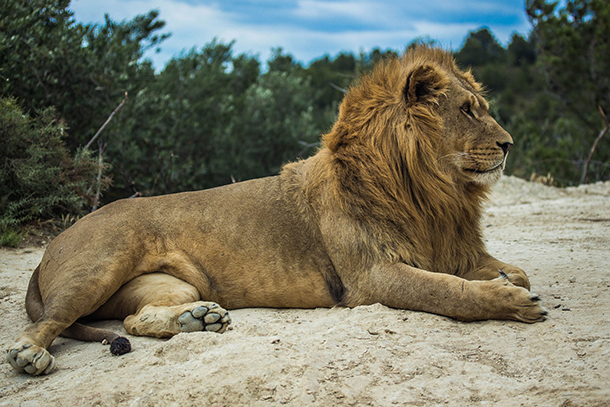
Felidae is a diverse taxonomic family that includes lions as well as house cats. (Photo: Pauline Guilmot, Flickr CC BY 2.0)
So, you'll see these animals, like I mentioned the scientists who discovered an unknown population of marooned house cats in interior Madagascar, which is not a place where cats normally occur. Those had been deposited by sailors at some points in human history, and those animals were like really big burly house cats with very kind of striped camouflaged looking coats that were making a living for themselves in the wild. And so that's one direction that house cats can go, and becoming almost more lion-like in the way that they look and act if they are reverting to a more wild environment.
At the same time, though, that's not really the evolutionary pressure that's on cats right now. Basically humans are just becoming a bigger and bigger global force, and really where the pay-dirt is, is still in our settlements and living closely with us, and that set of factors does not favor the cats that are big and strong and burly and good at fighting. It actually favors tame cats and meek cats that are able to get into our settlements and live in high densities and not fight so much but have as many babies and eat as much food as they possibly can. And so that's the cat that the 21st century belongs to. While cats can still hack it in the wilderness, the human settlements are really kind of where the future is at, and I think the only way that we as humans have really collectively influenced the feline phenotype, as far as I can tell, is by how fat cats have become as a population, not just our house pets which are frequently in a morbidly obese state, even stray cats and other animals that live in our settlements are really growing larger in a way that doesn't have to do with muscles necessary, but is more just kind of chubbiness.
CURWOOD: Hmmmm, our civilization promotes the fat cat, huh?
TUCKER: [LAUGHS] Yeah, it really does.
CURWOOD: Not just limited to felines, I gather. Hey, on a more personal note, Abby, how did the process of writing "Lion in the Living Room" change how you feel towards cats?
TUCKER: Well, that's an interesting question. I had always been a cat person, and I grew up with cats, and my mom grew up with cats, and it's just been kind of a familial trait, and I still think of myself very much as a cat person. But I don't think that I necessarily gave cats credit for what amazing and formidable animals that they are, even though I write about animals in a professional way and have gone to different places around the world to write about different rarified creatures in their native environment. I was just as guilty as the next person when it came to looking at my cats as little, cute little fur babies and infantilizing them and pretending that they needed help from me.

Abigail Tucker is a self-described “cat person” (Photo: courtesy of Simon & Schuster Publishing)
Now I understand that you know even though I been accustomed to traveling across the world looking for interesting animals, this is an interesting animal that has come to meet me in my living room. This creature is a creature of conquest and a creature that is a global survivor and is sort of an example of how amazing nature is. And I think that in a way, you know, that's a lot more kind of stimulating and interesting than thinking of my cat is just being a kind of slow-witted, furry human, which is how I used to think about them.
CURWOOD: Hmmmm...they're not so slow-witted are they?
TUCKER: They're really not.
CURWOOD: Abigail Tucker's book is called “The Lion in the Living Room: How House Cats Tamed Us and Took Over the World". Thanks, Abby, for taking the time today.
TUCKER: Thank you so much for having me.
Links
The Lion in the Living Room book
The American Bird Conservancy’s official statement about the threat of housecats to wildlife
Living on Earth wants to hear from you!
Living on Earth
62 Calef Highway, Suite 212
Lee, NH 03861
Telephone: 617-287-4121
E-mail: comments@loe.org
Newsletter [Click here]
Donate to Living on Earth!
Living on Earth is an independent media program and relies entirely on contributions from listeners and institutions supporting public service. Please donate now to preserve an independent environmental voice.
NewsletterLiving on Earth offers a weekly delivery of the show's rundown to your mailbox. Sign up for our newsletter today!
 Sailors For The Sea: Be the change you want to sea.
Sailors For The Sea: Be the change you want to sea.
 The Grantham Foundation for the Protection of the Environment: Committed to protecting and improving the health of the global environment.
The Grantham Foundation for the Protection of the Environment: Committed to protecting and improving the health of the global environment.
 Contribute to Living on Earth and receive, as our gift to you, an archival print of one of Mark Seth Lender's extraordinary wildlife photographs. Follow the link to see Mark's current collection of photographs.
Contribute to Living on Earth and receive, as our gift to you, an archival print of one of Mark Seth Lender's extraordinary wildlife photographs. Follow the link to see Mark's current collection of photographs.
 Buy a signed copy of Mark Seth Lender's book Smeagull the Seagull & support Living on Earth
Buy a signed copy of Mark Seth Lender's book Smeagull the Seagull & support Living on Earth

